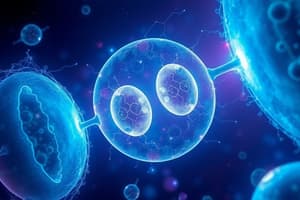Podcast
Questions and Answers
Flashcards
Cell Cycle
Cell Cycle
The series of events that cells go through to grow and divide.
Interphase
Interphase
The phase where the cell grows and prepares for division; makes up 90% of the cell cycle.
G1 Phase
G1 Phase
First phase of interphase where the cell grows and prepares for DNA replication.
S Phase
S Phase
Signup and view all the flashcards
Meiosis
Meiosis
Signup and view all the flashcards
Mitosis
Mitosis
Signup and view all the flashcards
Cytokinesis
Cytokinesis
Signup and view all the flashcards
Active Transport
Active Transport
Signup and view all the flashcards
Passive Transport
Passive Transport
Signup and view all the flashcards
Osmosis
Osmosis
Signup and view all the flashcards
Study Notes
Cell Cycle
- The cell cycle is a series of events that cells undergo for growth and division.
- It consists mainly of two phases: Interphase (90% of the cycle) and M Phase (Mitosis or Meiosis).
- Interphase is further divided into G1, S, and G2 phases.
- G1: Cell growth and preparation for DNA replication.
- S: DNA replication occurs.
- G2: Cell prepares for division, organelles replicate.
- M Phase: Cell division, followed by Cytokinesis (cytoplasm division).
Meiosis
- Meiosis produces four genetically different haploid gametes (sperm/egg).
- It involves two divisions: Meiosis I and Meiosis II.
- Meiosis I: Homologous chromosomes separate.
- Prophase I: Crossing over (genetic variation) occurs.
- Metaphase I: Homologous pairs line up randomly (independent assortment).
- Anaphase I: Homologous chromosomes separate.
- Telophase I and Cytokinesis: Two haploid cells form.
- Meiosis II: Sister chromatids separate.
- Prophase II: Chromosomes condense.
- Metaphase II: Chromosomes align at the equator.
- Anaphase II: Sister chromatids separate.
- Telophase II and Cytokinesis: Four haploid daughter cells form.
- Meiosis increases genetic variation through crossing over and independent assortment.
Mitosis
- Mitosis produces two identical diploid daughter cells.
- It is crucial for growth and repair of tissues.
- The main stages are Prophase, Metaphase, Anaphase, and Telophase (PMAT).
- Prophase: Chromosomes condense, spindle fibers form.
- Metaphase: Chromosomes align at the cell's equator.
- Anaphase: Sister chromatids separate.
- Telophase: Nuclear membranes reform, chromosomes decondense.
- Cytokinesis follows to split the cytoplasm and form two identical cells.
- Mitosis is essential for asexual reproduction in some organisms.
Cell Transport
- Cell transport refers to the movement of substances across the cell membrane.
- Passive transport doesn't require energy.
- Diffusion: Movement of molecules from high to low concentration.
- Osmosis: Water diffusion across a membrane.
- Facilitated diffusion: Transport proteins assist molecule movement.
- Active transport needs energy (ATP).
- Active transport moves substances against their concentration gradient (low to high).
- The sodium-potassium pump is an example of active transport.
- Bulk transport involves endocytosis (cell taking in material) – phagocytosis (solids) and pinocytosis (liquids), and exocytosis (cell expelling material).
Mitosis vs. Meiosis Comparison
- Mitosis produces identical diploid cells for growth and repair; meiosis produces different haploid gametes.
- Mitosis involves a single cell division; meiosis involves two cell divisions.
- Mitosis creates two daughter cells; meiosis creates four.
- Mitosis maintains chromosome number; meiosis reduces the chromosome number.
- Mitosis doesn't introduce genetic variation; meiosis creates unique combinations through crossing over and independent assortment.
Studying That Suits You
Use AI to generate personalized quizzes and flashcards to suit your learning preferences.




